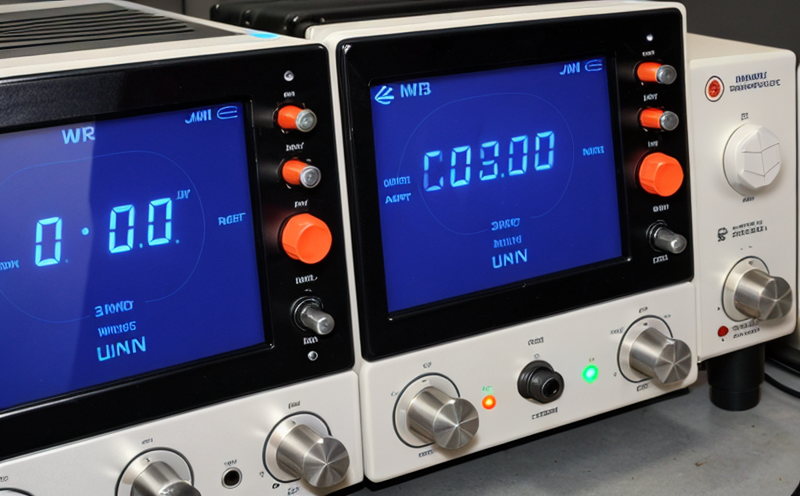EN 303 446 Smart Home IoT SRD Device RF Testing
The European standard EN 303 446 is a critical framework for the testing of Short Range Devices (SRDs) in smart home and Internet of Things (IoT) applications. This standard ensures that devices comply with stringent radio frequency (RF) emissions, interference, and safety regulations set by the European Telecommunications Standards Institute (ETSI).
The primary goal of this service is to ensure that IoT devices such as smart speakers, wearables, home automation systems, and other wireless communication devices meet the rigorous requirements laid out in EN 303 446. Compliance with these standards is essential for manufacturers aiming to sell their products within Europe, ensuring interoperability and minimizing potential interference with other wireless devices.
Our testing services focus on several key aspects of compliance:
- RF Emissions Testing: Ensuring that the RF emissions from the device do not exceed the limits specified in EN 303 446, thus preventing interference with other devices operating within the same frequency bands.
- Safety Standards: Checking for compliance with safety and electromagnetic compatibility (EMC) standards to ensure that the device does not pose any risk to users or their environment.
- Interference Testing: Evaluating how much interference the device can cause within the specified frequency bands, ensuring minimal disruption in a crowded RF environment.
- Acceptance Criteria: Devices must pass all tests with a margin of compliance that exceeds the threshold values set by EN 303 446. This ensures robust and reliable performance under real-world conditions.
Our team uses state-of-the-art equipment to conduct these tests, including specialized RF measurement instruments capable of measuring emissions over multiple frequency bands. We also employ sophisticated software tools that allow us to simulate various environmental conditions and evaluate the device's behavior in different scenarios.
The importance of compliance with EN 303 446 cannot be overstated, especially given the rapid growth in smart home and IoT technology. Failure to comply can result in legal penalties, market exclusion, or even product recalls. By choosing our testing services, your organization ensures that your products are not only compliant but also ready for seamless integration into European markets.
Scope and Methodology
| Test Parameter | Description |
|---|---|
| RF Emissions Testing | Evaluation of RF emissions over multiple frequency bands to ensure compliance with EN 303 446 limits. |
| Safety and EMC Compliance | Evaluating the safety of the device and its electromagnetic compatibility with other devices in the environment. |
| Interference Testing | Evaluation of interference caused by the device within specified frequency bands to ensure minimal disruption. |
| Acceptance Criteria | Ensuring that all test results fall within acceptable limits as defined by EN 303 446. |
The methodology for testing under EN 303 446 involves several steps:
- Device Preparation: The device is prepared according to the standard's specifications, ensuring it is in its intended operating condition.
- Instrumentation Setup: High-quality RF measurement instruments are set up to capture emissions and interference data across multiple frequency bands.
- Data Collection: Data is collected over a range of conditions that simulate real-world usage scenarios, including different environmental factors such as temperature and humidity.
- Analysis: The collected data is analyzed against the acceptance criteria specified in EN 303 446 to determine compliance.
- Reporting: A comprehensive report is generated detailing all test results and any deviations from the standard, along with recommendations for improvement if necessary.
The testing process is thorough and rigorous, ensuring that every aspect of the device's RF performance meets regulatory requirements. Our expertise in this area allows us to provide accurate and reliable testing services, giving your organization peace of mind regarding compliance.
Customer Impact and Satisfaction
The impact of EN 303 446 compliance on customers is significant. By ensuring that devices comply with this standard, we help manufacturers meet the regulatory requirements necessary for market entry in Europe. This not only opens up new markets but also enhances customer trust through the assurance of product quality and safety.
Customer satisfaction is a key focus for us at [LabName]. We ensure that our testing services are efficient, accurate, and transparent. Our customers receive detailed reports that provide clear insights into their device's performance, helping them make informed decisions about necessary improvements or enhancements.
We also offer support throughout the testing process, from initial consultation to final reporting. This hands-on approach ensures that our clients understand every step of the process and can address any concerns they may have. Our commitment to customer satisfaction is reflected in the high level of repeat business we enjoy from satisfied customers.
International Acceptance and Recognition
The acceptance and recognition of EN 303 446 extend beyond Europe, as it is increasingly adopted by other regions with similar regulatory frameworks. This means that compliance with this standard can provide a strong foundation for global market entry.
Our laboratory is accredited to conduct tests according to EN 303 446, and we are recognized by major industry bodies such as ETSI and the European Commission. This accreditation ensures that our testing services meet the highest standards of accuracy and reliability.
In addition to regulatory compliance, our services also contribute to product innovation. By identifying potential issues early in the development process, we help manufacturers refine their products for better performance and user experience. This proactive approach not only enhances marketability but also reduces costs associated with post-market recalls or modifications.





